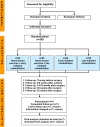Perioperative rehabilitation in operation for lung cancer (PROLUCA) - rationale and design
- PMID: 24898680
- PMCID: PMC4053552
- DOI: 10.1186/1471-2407-14-404
Perioperative rehabilitation in operation for lung cancer (PROLUCA) - rationale and design
Abstract
Background: The purpose of the PROLUCA study is to investigate the efficacy of preoperative and early postoperative rehabilitation in a non-hospital setting in patients with operable lung cancer with special focus on exercise.
Methods: Using a 2 x 2 factorial design with continuous effect endpoint (Maximal Oxygen Uptake (VO2peak)), 380 patients with non-small cell lung cancer (NSCLC) stage I-IIIa referred for surgical resection will be randomly assigned to one of four groups: (1) preoperative and early postoperative rehabilitation (starting two weeks after surgery); (2) preoperative and late postoperative rehabilitation (starting six weeks after surgery); (3) early postoperative rehabilitation alone; (4) today's standard care which is postoperative rehabilitation initiated six weeks after surgery. The preoperative rehabilitation program consists of an individually designed, 30-minute home-based exercise program performed daily. The postoperative rehabilitation program consists of a supervised group exercise program comprising cardiovascular and resistance training two-hour weekly for 12 weeks combined with individual counseling. The primary study endpoint is VO2peak and secondary endpoints include: Six-minute walk distance (6MWD), one-repetition-maximum (1RM), pulmonary function, patient-reported outcomes (PROs) on health-related quality of life (HRQoL), symptoms and side effects of the cancer disease and the treatment of the disease, anxiety, depression, wellbeing, lifestyle, hospitalization time, sick leave, work status, postoperative complications (up to 30 days after surgery) and survival. Endpoints will be assessed at baseline, the day before surgery, pre-intervention, post-intervention, six months after surgery and one year after surgery.
Discussion: The results of the PROLUCA study may potentially contribute to the identification of the optimal perioperative rehabilitation for operable lung cancer patients focusing on exercise initiated immediately after diagnosis and rehabilitation shortly after surgery.
Trial registration: NCT01893580.
Figures
Similar articles
-
Perioperative Rehabilitation in Operable Lung Cancer Patients (PROLUCA): A Feasibility Study.Integr Cancer Ther. 2016 Dec;15(4):455-466. doi: 10.1177/1534735416635741. Epub 2016 May 4. Integr Cancer Ther. 2016. PMID: 27151595 Free PMC article.
-
The lung cancer exercise training study: a randomized trial of aerobic training, resistance training, or both in postsurgical lung cancer patients: rationale and design.BMC Cancer. 2010 Apr 21;10:155. doi: 10.1186/1471-2407-10-155. BMC Cancer. 2010. PMID: 20409311 Free PMC article. Clinical Trial.
-
Early initiated postoperative rehabilitation reduces fatigue in patients with operable lung cancer: A randomized trial.Lung Cancer. 2018 Dec;126:125-132. doi: 10.1016/j.lungcan.2018.10.025. Epub 2018 Nov 2. Lung Cancer. 2018. PMID: 30527176 Clinical Trial.
-
Exercise training undertaken by people within 12 months of lung resection for non-small cell lung cancer.Cochrane Database Syst Rev. 2019 Jun 17;6(6):CD009955. doi: 10.1002/14651858.CD009955.pub3. Cochrane Database Syst Rev. 2019. PMID: 31204439 Free PMC article.
-
Exercise training for advanced lung cancer.Cochrane Database Syst Rev. 2019 Feb 11;2(2):CD012685. doi: 10.1002/14651858.CD012685.pub2. Cochrane Database Syst Rev. 2019. PMID: 30741408 Free PMC article.
Cited by
-
Impact of pulmonary rehabilitation on postoperative complications in patients with lung cancer and chronic obstructive pulmonary disease.Thorac Cancer. 2017 Sep;8(5):451-460. doi: 10.1111/1759-7714.12466. Epub 2017 Jul 11. Thorac Cancer. 2017. PMID: 28696575 Free PMC article.
-
A score prediction model for predicting the heterogeneity symptom trajectories among lung cancer patients during perioperative period: a longitudinal observational study.Ann Med. 2025 Dec;57(1):2479588. doi: 10.1080/07853890.2025.2479588. Epub 2025 Mar 20. Ann Med. 2025. PMID: 40114445 Free PMC article.
-
Impact of preoperative exercise therapy on surgical outcomes in lung cancer patients with or without COPD: a systematic review and meta-analysis.Cancer Manag Res. 2019 Feb 20;11:1765-1777. doi: 10.2147/CMAR.S186432. eCollection 2019. Cancer Manag Res. 2019. PMID: 30858729 Free PMC article. Review.
-
Perioperative Rehabilitation in Operable Lung Cancer Patients (PROLUCA): A Feasibility Study.Integr Cancer Ther. 2016 Dec;15(4):455-466. doi: 10.1177/1534735416635741. Epub 2016 May 4. Integr Cancer Ther. 2016. PMID: 27151595 Free PMC article.
-
Non-invasive Mechanical Ventilation in Lung Cancer: Physiological Principles and Clinical Utilization in Surgical and Non-surgical Settings.Thorac Res Pract. 2025 Jan 3;26(1):32-39. doi: 10.4274/ThoracResPract.2024.23076. Thorac Res Pract. 2025. PMID: 39930750 Free PMC article.
References
-
- Storm HH, Engholm G, Hakulinen T, Tryggvadóttir L, Klint A, Gislum M, Kejs AMT, Bray F. Survival of patients diagnosed with cancer in the Nordic countries up to 1999–2003 followed to the end of 2006. A critical overview of the results. Acta Oncol. 2010;49:532–544. - PubMed
-
- Group DLC. Danish Lunge Cancer Group Annual Report 2011. 2011.
-
- Lim E, Baldwin D, Beckles M, Duffy J, Entwisle J, Faivre-Finn C, Kerr K, Macfie A, McGuigan J, Padley S, Popat S, Screaton N, Snee M, Waller D, Warburton C, Win T. Guidelines on the radical management of patients with lung cancer. Thorax. 2010;Suppl 3:1–27. - PubMed
Publication types
MeSH terms
Associated data
LinkOut - more resources
Full Text Sources
Other Literature Sources
Medical
Miscellaneous



